Abstract
The potential involvement of lipoxygenase metabolites in the tumour growth stimulatory activity of arachidonic and linoleic acid has been studied using the 5-lipoxygenase inhibitors, BWA4C, BWB70C and Zileuton. In vitro the former two agents were relatively potent inhibitors of growth of murine adenocarcinomas (MACs) with IC50 values < 10 microM, whereas Zileuton was less effective. In vivo studies showed BWA4C to be an effective inhibitor of the growth of both the MAC26 and MAC16 tumours at dose levels between 5 and 25 mg kg-1 (b.d.). The growth rate of the MAC26 tumour was also decreased by BWB70C at 25 mg kg-1, whereas lower doses were either ineffective or stimulated tumour growth. This differential effect of the 5-lipoxygenases inhibitors on tumour growth may arise from effects on the 12- and 15-lipoxygenase pathways. To quantify the effect cells were labelled with [3H]arachidonic acid and the biosynthesis of 5-, 12- and 15-hydroxyeicosatetraenoic acid (HETE) was analysed by high-performance liquid chromatography. All three agents caused a decrease in 5-HETE production, although the effect was less pronounced with Zileuton. In MAC26 cells both BWA4C and BWB70C caused a decrease in 12-HETE formation whereas Zileuton had no effect on the other lipoxygenase pathways. The inhibitory effect of these agents on cell growth may result from an imbalance of metabolism of arachidonic acid between the 5-, 12- and 15-lipoxygenase pathways.
Full text
PDF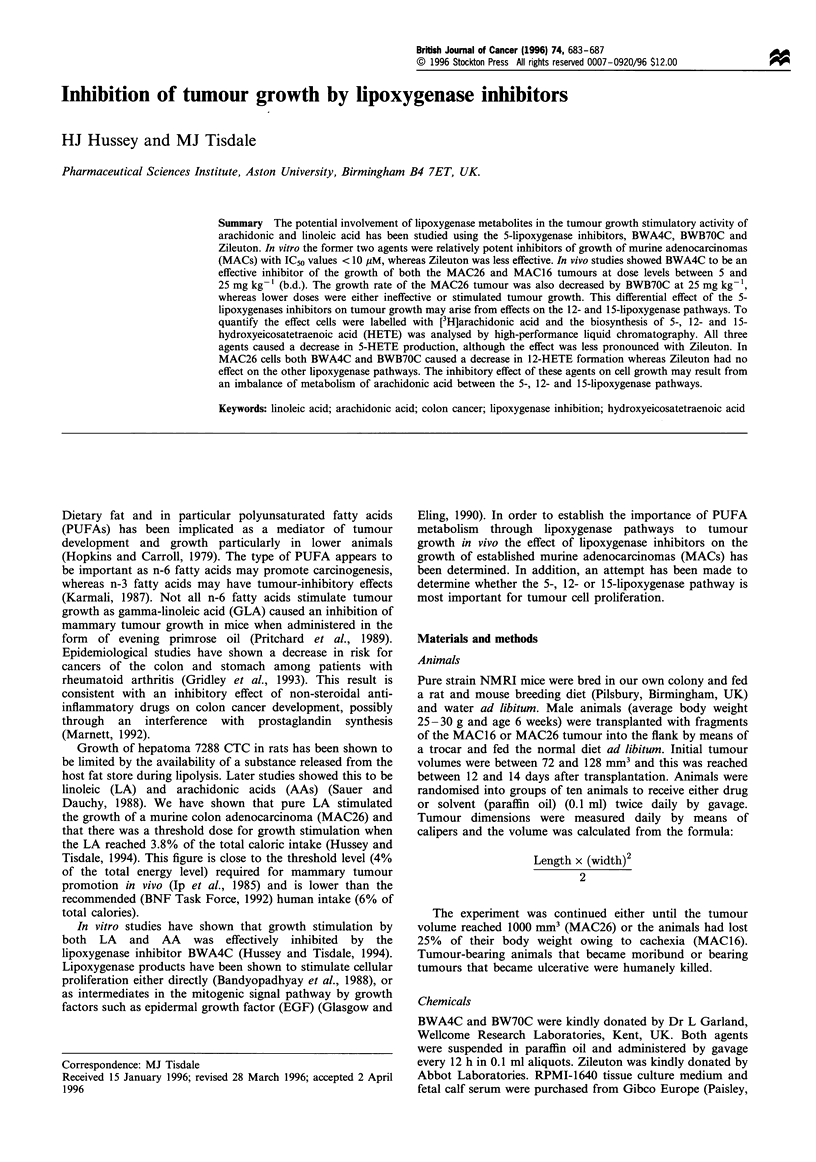
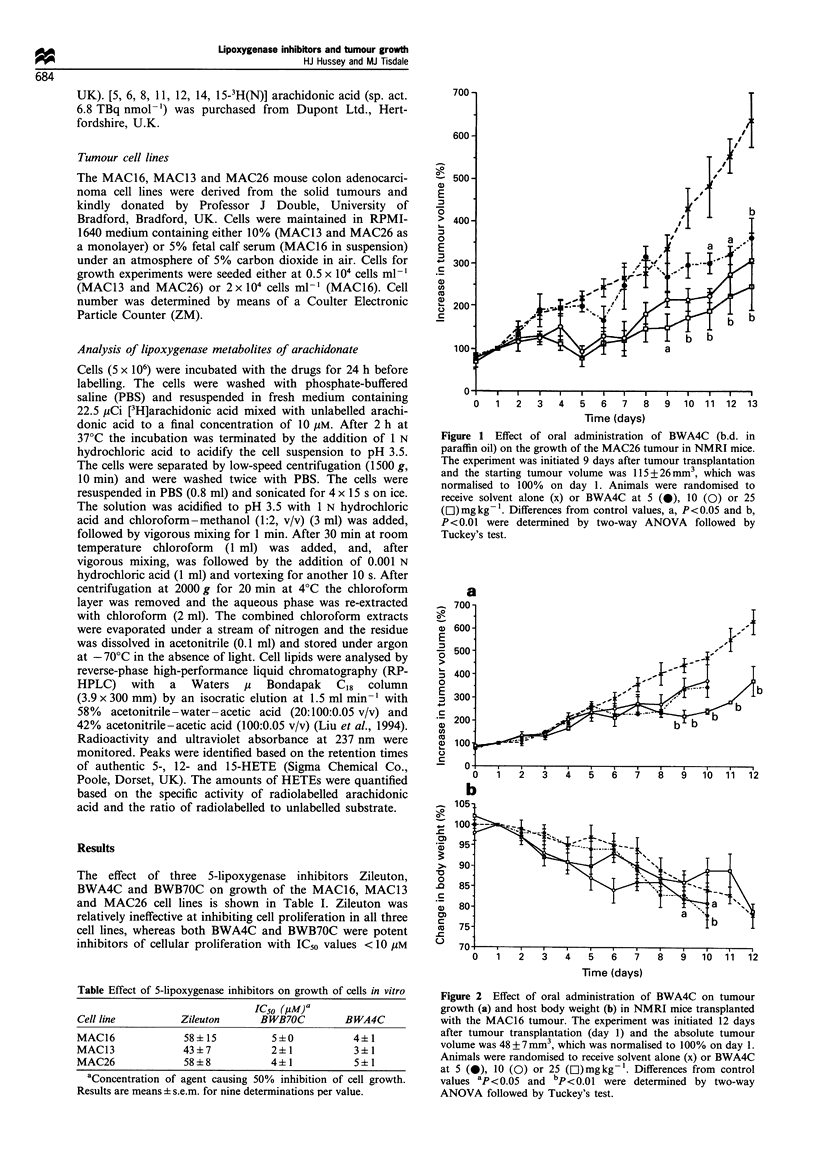
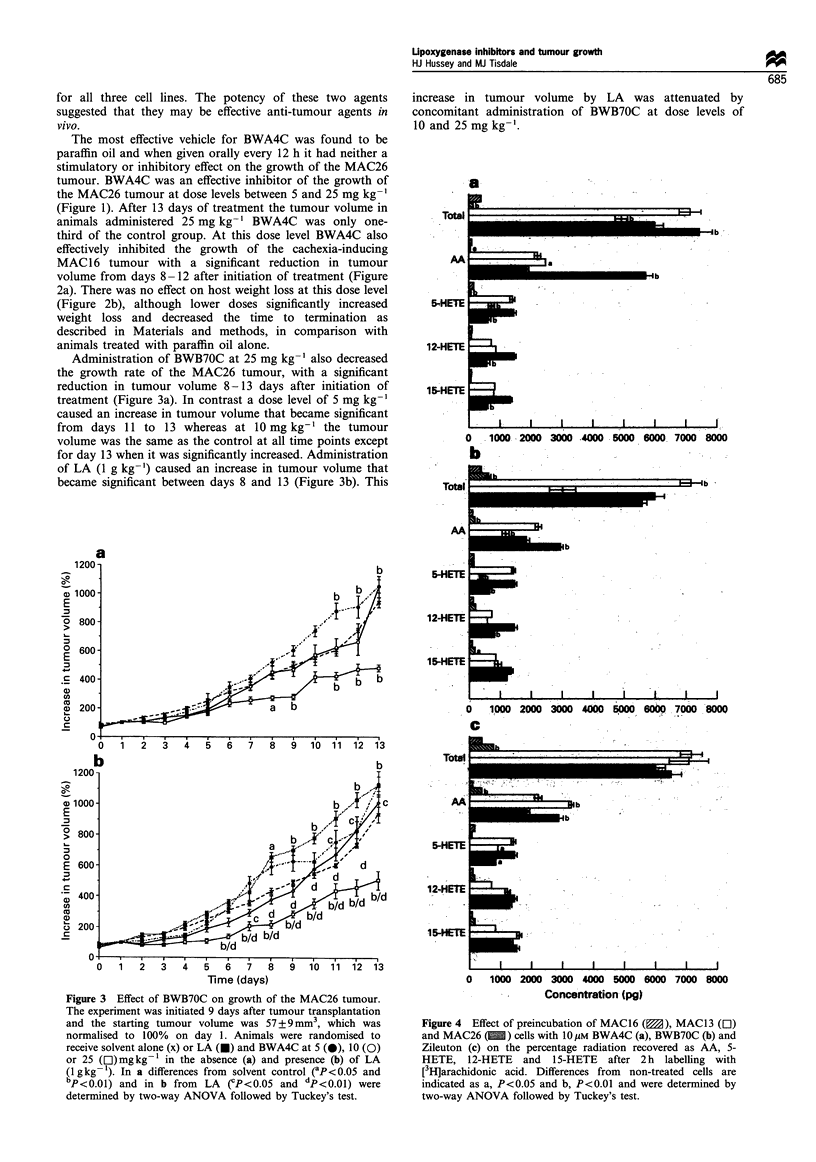
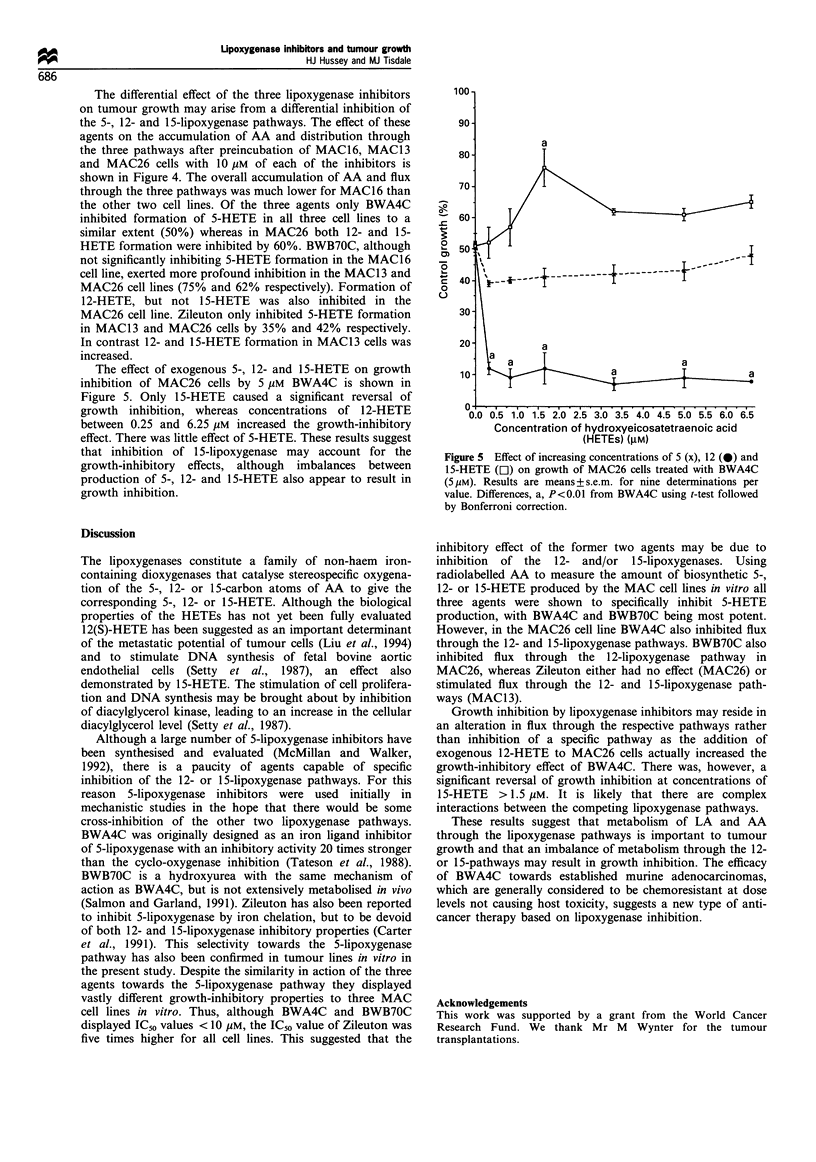
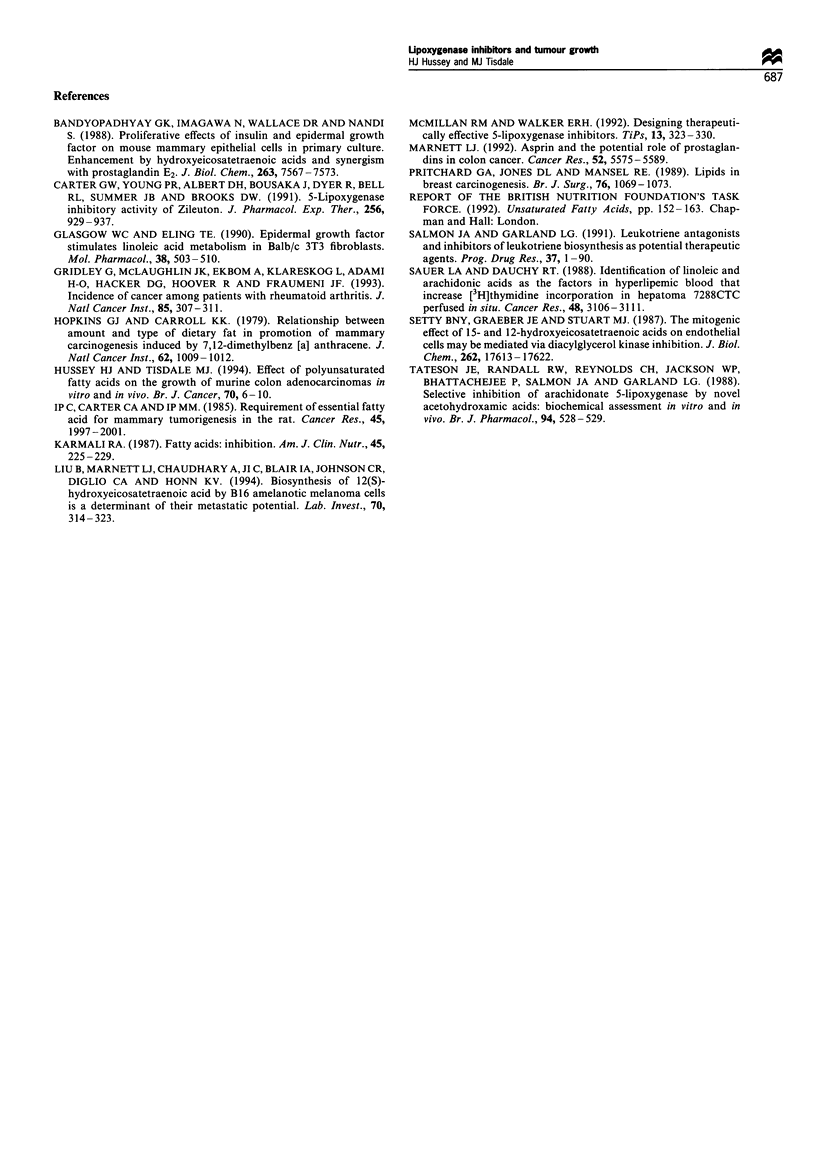
Selected References
These references are in PubMed. This may not be the complete list of references from this article.
- Bandyopadhyay G. K., Imagawa W., Wallace D. R., Nandi S. Proliferative effects of insulin and epidermal growth factor on mouse mammary epithelial cells in primary culture. Enhancement by hydroxyeicosatetraenoic acids and synergism with prostaglandin E2. J Biol Chem. 1988 Jun 5;263(16):7567–7573. [PubMed] [Google Scholar]
- Carter G. W., Young P. R., Albert D. H., Bouska J., Dyer R., Bell R. L., Summers J. B., Brooks D. W. 5-lipoxygenase inhibitory activity of zileuton. J Pharmacol Exp Ther. 1991 Mar;256(3):929–937. [PubMed] [Google Scholar]
- Glasgow W. C., Eling T. E. Epidermal growth factor stimulates linoleic acid metabolism in BALB/c 3T3 fibroblasts. Mol Pharmacol. 1990 Oct;38(4):503–510. [PubMed] [Google Scholar]
- Gridley G., McLaughlin J. K., Ekbom A., Klareskog L., Adami H. O., Hacker D. G., Hoover R., Fraumeni J. F., Jr Incidence of cancer among patients with rheumatoid arthritis. J Natl Cancer Inst. 1993 Feb 17;85(4):307–311. doi: 10.1093/jnci/85.4.307. [DOI] [PubMed] [Google Scholar]
- Hopkins G. J., Carroll K. K. Relationship between amount and type of dietary fat in promotion of mammary carcinogenesis induced by 7,12-dimethylbenz[a]anthracene. J Natl Cancer Inst. 1979 Apr;62(4):1009–1012. [PubMed] [Google Scholar]
- Hussey H. J., Tisdale M. J. Effect of polyunsaturated fatty acids on the growth of murine colon adenocarcinomas in vitro and in vivo. Br J Cancer. 1994 Jul;70(1):6–10. doi: 10.1038/bjc.1994.241. [DOI] [PMC free article] [PubMed] [Google Scholar]
- Ip C., Carter C. A., Ip M. M. Requirement of essential fatty acid for mammary tumorigenesis in the rat. Cancer Res. 1985 May;45(5):1997–2001. [PubMed] [Google Scholar]
- Karmali R. A. Fatty acids: inhibition. Am J Clin Nutr. 1987 Jan;45(1 Suppl):225–229. doi: 10.1093/ajcn/45.1.225. [DOI] [PubMed] [Google Scholar]
- Liu B., Marnett L. J., Chaudhary A., Ji C., Blair I. A., Johnson C. R., Diglio C. A., Honn K. V. Biosynthesis of 12(S)-hydroxyeicosatetraenoic acid by B16 amelanotic melanoma cells is a determinant of their metastatic potential. Lab Invest. 1994 Mar;70(3):314–323. [PubMed] [Google Scholar]
- Marnett L. J. Aspirin and the potential role of prostaglandins in colon cancer. Cancer Res. 1992 Oct 15;52(20):5575–5589. [PubMed] [Google Scholar]
- McMillan R. M., Walker E. R. Designing therapeutically effective 5-lipoxygenase inhibitors. Trends Pharmacol Sci. 1992 Aug;13(8):323–330. doi: 10.1016/0165-6147(92)90100-k. [DOI] [PubMed] [Google Scholar]
- Pritchard G. A., Jones D. L., Mansel R. E. Lipids in breast carcinogenesis. Br J Surg. 1989 Oct;76(10):1069–1073. doi: 10.1002/bjs.1800761028. [DOI] [PubMed] [Google Scholar]
- Sauer L. A., Dauchy R. T. Identification of linoleic and arachidonic acids as the factors in hyperlipemic blood that increase [3H]thymidine incorporation in hepatoma 7288CTC perfused in situ. Cancer Res. 1988 Jun 1;48(11):3106–3111. [PubMed] [Google Scholar]
- Setty B. N., Graeber J. E., Stuart M. J. The mitogenic effect of 15- and 12-hydroxyeicosatetraenoic acid on endothelial cells may be mediated via diacylglycerol kinase inhibition. J Biol Chem. 1987 Dec 25;262(36):17613–17622. [PubMed] [Google Scholar]
- Tateson J. E., Randall R. W., Reynolds C. H., Jackson W. P., Bhattacherjee P., Salmon J. A., Garland L. G. Selective inhibition of arachidonate 5-lipoxygenase by novel acetohydroxamic acids: biochemical assessment in vitro and ex vivo. Br J Pharmacol. 1988 Jun;94(2):528–539. doi: 10.1111/j.1476-5381.1988.tb11557.x. [DOI] [PMC free article] [PubMed] [Google Scholar]


